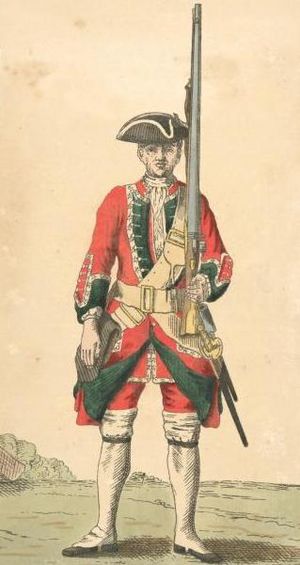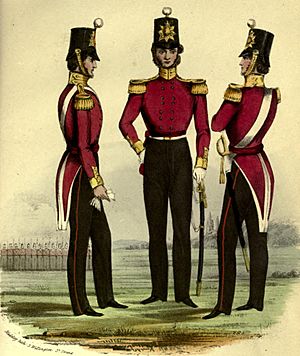46th (South Devonshire) Regiment of Foot facts for kids
Quick facts for kids 46th (South Devonshire) Regiment of Foot |
|
|---|---|
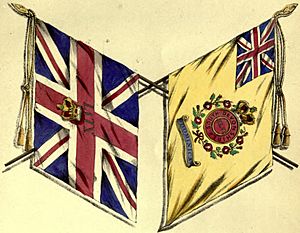
Colours of the 46th Regiment
|
|
| Active | 1741–1881 |
| Country | |
| Branch | |
| Type | Line Infantry |
| Role | Light Infantry |
| Size | One battalion (two battalions 1800–1802) |
| Nickname(s) | The Red Feathers, Murray's Bucks, The Surprisers, The Lacedemonians. |
| Colors | Light Yellow Facing, Silver Braided Lace |
| Engagements | Jacobite rising French and Indian War American Revolutionary War Napoleonic Wars Crimean War |
The 46th (South Devonshire) Regiment of Foot was a group of soldiers who fought on foot for the British Army. It was started in 1741. Later, in 1881, it joined with another group called the 32nd (Cornwall) Regiment of Foot. Together, they formed a new regiment known as the Duke of Cornwall's Light Infantry. The 46th Regiment then became the 2nd Battalion of this new group.
Contents
History of the 46th Regiment
Early Battles and Adventures
The regiment began in Newcastle upon Tyne in 1741. It was first called "John Price's Regiment of Foot" after its founder, John Price. Soon after, the soldiers went to Scotland. They fought in the Battle of Prestonpans in September 1745. This battle was part of the Jacobite rising, when some people tried to put a different king on the throne.
The regiment's number changed a few times. By 1751, it was officially known as the 46th Regiment of Foot. After spending eight years in Ireland, the soldiers sailed to Nova Scotia in May 1757. They were going to fight in the French and Indian War.
They saw action at several important places:
- The attack on Fort Ticonderoga in July 1758.
- The capture of Fort Niagara in July 1759.
- The Montreal Campaign from August to September 1760.
After these battles, the regiment moved to the West Indies in October 1761. They helped capture Martinique in January 1762. They also took part in the attack on Morro Castle in July 1762 and the capture of Havana in August 1762. The regiment returned home to Britain in 1767.
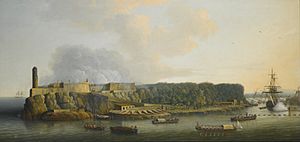
Fighting in the American Revolutionary War
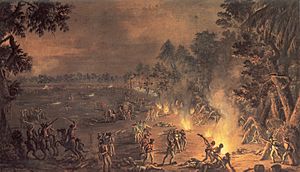
In April 1776, the regiment arrived in North Carolina to fight in the American Revolutionary War. They were involved in many battles, including:
- The Battle of Sullivan's Island in June 1776.
- The Battle of Long Island in August 1776.
- The Battle of White Plains in October 1776.
- The Battle of Fort Washington in November 1776.
They also fought in the Philadelphia campaign. This included the Battle of Brandywine in September 1777, the Battle of Paoli in September 1777, and the Battle of Germantown in October 1777.
It was after the Battle of Paoli that the regiment earned its famous nickname, the Red Feathers. During that battle, the light company of the regiment fought very fiercely. To make sure no one else was blamed for their actions, the soldiers decided to put bright red feathers in their caps. This way, everyone knew who they were.
The regiment continued to fight in the Battle of Monmouth in June 1778. They also took part in operations against New Bedford and Martha's Vineyard in September 1778. In November 1778, they sailed back to the West Indies. There, they helped attack Saint Lucia in December 1778. The regiment then returned to England. In 1782, it was officially renamed the 46th (South Devonshire) Regiment of Foot.
Napoleonic Wars and West Indies Service
In November 1794, the regiment went back to the West Indies. They helped stop a rebellion by the Carib people on Saint Vincent. They returned home in November 1796.
They were sent to the West Indies again in April 1804. In February 1805, they bravely defended Dominica against a French attack for over a week. The French eventually gave up, and this action earned the regiment its first battle honour, "Dominica".
In May 1806, 40 soldiers from the regiment went on a special mission. They boarded a ship called Duke of Montrose and chased two French privateer ships. They managed to capture one of them, the Impériale, and its crew. The regiment also took part in the invasion of Martinique in February 1809. They finally returned to England in December 1811.
Time in Australia
In August 1813, the regiment sailed to New South Wales in Australia. They were stationed in Hobart on Van Diemens Land. Their job was to deal with groups of outlaws known as bushrangers.
In April 1816, the Governor, Lachlan Macquarie, gave the regiment orders to go on expeditions against some Aboriginal groups in New South Wales. The soldiers were told to take as many people prisoner as they could. These orders were very harsh and were later used by other officials in Australia during the Australian frontier wars.
After their time in Australia, the regiment sailed to Madras in India in September 1817. After serving in India, they returned to England in March 1833.
The Victorian Era and Final Years
In the summer of 1854, the regiment was sent to the Crimea. They fought in several major battles:
- The Battle of Alma in September 1854.
- The Battle of Balaclava in October 1854.
- The Battle of Inkerman in November 1854.
They also took part in the long Siege of Sebastopol during the winter of 1854.
In the 1870s, the British Army made some big changes called the Cardwell Reforms. As part of these changes, the 46th Regiment was linked with the 32nd (Cornwall) Regiment of Foot. They shared a training base in Bodmin.
Then, on July 1, 1881, more changes happened with the Childers Reforms. The 46th Regiment officially joined with the 32nd (Cornwall) Regiment of Foot. They became the Duke of Cornwall's Light Infantry. The 46th Regiment became the 2nd Battalion of this new, larger regiment.
Battle Honours
Battle honours are special awards given to regiments for their bravery in important battles. The 46th Regiment earned these:
- Dominica (1805)
- Crimean War: Sevastopol
Colonels of the Regiment
A Colonel of the Regiment was a very senior officer who was in charge of the regiment. Here are some of the people who held this important role:
- 1741–1743: Brig-Gen. John Price
- 1743–1764: Lt-Gen. Hon. Thomas Murray
- 1770–1881: Gen. Charles Stuart


